A Study of Farmers’ Behavior in Classifying Domestic Waste Based on the Participants Intellectual Decision Model
Abstract
1. Introduction
2. Theoretical Analysis and Research Hypotheses
2.1. Natural Attributes
2.2. Participant Status
2.2.1. Personal Characteristics
2.2.2. Governance Attitudes
2.2.3. Environmental Emotions
2.2.4. Difficulty Perception
2.3. Conditional Control
2.4. Community Attributes and Operating Rules
2.4.1. Community Attributes
2.4.2. Operating Rules
2.5. Perception of the Current Situation
2.6. External Action Situation
2.7. Expected Outcomes
3. Materials and Methods
3.1. Research Methods
3.1.1. Ordered Logistic Models
3.1.2. DEMATEL-ISM
3.2. Data Sources
3.3. Variable Settings and Statistical Characteristics
3.3.1. Farmers’ Behavior in Classifying Domestic Waste
3.3.2. Natural Attributes
3.3.3. Participant Status
3.3.4. Conditional Control
3.3.5. Community Attributes and Operating Rules
3.3.6. Perceived Status Quo
3.3.7. External Action Situation
3.3.8. Expected Outcomes
4. Results
4.1. Factors Influencing Farmers’ Domestic Waste Classification Behavior
4.2. Causal Association Characterization Based on DEMATEL
4.3. Characterization of Causal Hierarchy Based on ISM
5. Discussion
6. Conclusions and Implications
6.1. Conclusions
6.2. Implications
6.3. Limitation and Future Work
Author Contributions
Funding
Institutional Review Board Statement
Informed Consent Statement
Data Availability Statement
Conflicts of Interest
References
- Zhang, X.; He, J.; Wang, X. Distribution, Localization, Resource Utilization, and Micro-Circulation—The Innovative Solution To China’s Garbage Treatment. Adm. Reform 2021, 13, 35–41. [Google Scholar] [CrossRef]
- Wang, X.; He, J. Research on Promoting Rural Residents’ Endogenous Driving Force of Participation in the Environmental Governance: Based on Five Typical Cases. Ecol. Econ. 2021, 37, 200–206. [Google Scholar]
- Du, Y.; Liu, N.; Chen, L. An Analysis of Farmers’ Collective Inaction in Rural Environmental Governance and Its Turning Logic. China Rural Surv. 2021, 42, 81–96. [Google Scholar]
- Lebersorger, S.; Beigl, P. Municipal Solid Waste Generation in Municipalities: Quantifying Impacts of Household Structure, Commercial Waste and Domestic Fuel. Waste Manag. 2011, 31, 1907–1915. [Google Scholar] [CrossRef]
- Wan, C.; Shen, G.Q.; Yu, A. Key Determinants of Willingness to Support Policy Measures on Recycling: A Case Study in Hong Kong. Environ. Sci. Policy 2015, 54, 409–418. [Google Scholar] [CrossRef]
- Wan, C.; Shen, G.Q. Perceived Policy Effectiveness and Recycling Behaviour: The Missing Link. Waste Manag. 2013, 33, 783–784. [Google Scholar] [CrossRef]
- Purcell, M.; Magette, W.L. Prediction of Household and Commercial BMW Generation According to Socio-Economic and Other Factors for the Dublin Region. Waste Manag. 2009, 29, 1237–1250. [Google Scholar] [CrossRef]
- Shen, J.; Qu, M.; Zheng, D.; Zhang, Y. Research on the Farmers’behavior of Domestic Waste Source sorting—Based onTPB and NAM Integration Framework. J. Arid Land Resources Environ. 2020, 34, 75–81. [Google Scholar] [CrossRef]
- Goh, E.; Esfandiar, K.; Jie, F.; Brown, K.; Djajadikerta, H. Please Sort out Your Rubbish! An Integrated Structural Model Approach to Examine Antecedents of Residential Households’ Waste Separation Behaviour. J. Clean. Prod. 2022, 355, 131789. [Google Scholar] [CrossRef]
- Sguin, C.; Pelletier, L.G.; Hunsley, J. Toward a Model of Environmental Activism. Environ. Behav. 1998, 30, 628–652. [Google Scholar] [CrossRef]
- Liao, B. Family Livelihood Capital, the Recognition and the Behavior of Paying for the Governance of Rural Living Environment for Farmers: Taking 873 Farmers in Jiangxi Province for Example. J. Agro-For. Econ. Manag. 2021, 20, 598–609. [Google Scholar] [CrossRef]
- Cai, Q.; Zhu, Y. Social Trust, Relational Networks and Farmers’ Participation in Rural Public Goods Supply. Chin. Rural Econ. 2015, 31, 57–69. [Google Scholar]
- Phuphisith, S.; Kurisu, K.; Hanaki, K. A Comparison of the Practices and Influential Factors of Pro-Environmental Behaviors in Three Asian Megacities: Bangkok, Tokyo, and Seoul. J. Clean. Prod. 2020, 253, 119882. [Google Scholar] [CrossRef]
- Sadeghi, S.; Asadi, Z.S.; Rakhshani, T.; Mohammadi, M.J.; Azadi, N.A. The Effect of an Educational Intervention Based on the Integrated Behavior Model (IBM) on the Waste Separation: A Community Based Study. Clin. Epidemiol. Glob. Health 2020, 8, 576–580. [Google Scholar] [CrossRef]
- Tadesse, T.; Ruijs, A.; Hagos, F. Household Waste Disposal in Mekelle City, Northern Ethiopia. Waste Manag. 2008, 28, 2003–2012. [Google Scholar] [CrossRef]
- Zaikova, A.; Deviatkin, I.; Havukainen, J.; Horttanainen, M.; Astrup, T.F.; Saunila, M.; Happonen, A. Factors Influencing Household Waste Separation Behavior: Cases of Russia and Finland. Recycling 2022, 7, 52. [Google Scholar] [CrossRef]
- Breitenmoser, L.; Behner, D.; Baertsch, A.; Mondardini, M.R.; Hugi, C. Citizen Science-Based Waste Diaries: An Exploratory Case Study of Household Waste in Switzerland. Sustainability 2024, 16, 3800. [Google Scholar] [CrossRef]
- Allison, E. The Reincarnation of Waste: A Case Study of Spiritual Ecology Activism for Household Solid Waste Management: The Samdrup Jongkhar Initiative of Rural Bhutan. Religions 2019, 10, 514. [Google Scholar] [CrossRef]
- Zuo, X.; Kang, M.; Lu, J. The impact of social interaction and Internet use on rural residents’ willingness to sort domestic waste. Resour. Sci. 2022, 44, 47–58. [Google Scholar] [CrossRef]
- Jia, Y.; Zhao, M. Farmers’ Preference for Source Classification of Domestic Waste. J. Arid Land Resour. Environ. 2021, 35, 40–47. [Google Scholar] [CrossRef]
- Liu, Y.; Zhu, H.; Zhang, L. Can Information Intervention Improve the Effectiveness of Farmers’ Waste Classification: Evidence from a Farmers’ Behavior Experiment in the Taihu Lake Basin. J. Agrotech. Econ. 2023, 42, 112–126. [Google Scholar] [CrossRef]
- Zhang, B.; Lai, K.; Wang, B.; Wang, Z. From Intention to Action: How Do Personal Attitudes, Facilities Accessibility, and Government Stimulus Matter for Household Waste Sorting? J. Environ. Manag. 2019, 233, 447–458. [Google Scholar] [CrossRef] [PubMed]
- Field, B.C.; Ostrom, E. Governing the Commons: The Evolution of Institutions for Collective Action. Land Econ. 1992, 68, 354. [Google Scholar] [CrossRef]
- Ostrom, E. Building a Better Micro-Foundation for Institutional Analysis. Behav. Brain Sci. 2005, 28, 831–832. [Google Scholar] [CrossRef]
- Wang, Y.; Shu, Q. Review and Prospect of Collective Action Studies on Commons Governance. China Popul. Environ. 2021, 31, 118–131. [Google Scholar]
- Cao, Y.; Wu, C.; Zhu, Y. Farmers Land Expropriation Willingness Based on IAD Extension Decision Model. Econ. Geogr. 2015, 35, 141–148. [Google Scholar] [CrossRef]
- Liu, M. Reform of the Collective Forest Rights System: A Study of Farmers’ Planting Intentions—Based on Elinor Ostrom’s IAD Extension Model. J. Manag. World 2011, 212, 93–98. [Google Scholar] [CrossRef]
- Mairizal, A.Q.; Sembada, A.Y.; Tse, K.M.; Rhamdhani, M.A. Electronic Waste Generation, Economic Values, Distribution Map, and Possible Recycling System in Indonesia. J. Clean. Prod. 2021, 293, 126096. [Google Scholar] [CrossRef]
- Abbondanza, M.; Souza, R.G. Estimating the Generation of Household E-Waste in Municipalities Using Primary Data from Surveys: A Case Study of Sao Jose Dos Campos, Brazil. Waste Manag. 2019, 85, 374–384. [Google Scholar] [CrossRef] [PubMed]
- Wang, B.; Yang, F.; Wang, Y. Farmers’ Participation in Improving Living Environment from the Perspective of Environmental Literacy. J. Agro-For. Econ. Manag. 2021, 20, 740–748. [Google Scholar] [CrossRef]
- Zhu, H.; Shan, H.; Shen, Y.; Zhang, L.; Zhou, Y. The Influence of Digital Literacy on Villagers’ Waste Classification Willingness and Behaviour. J. Jiangsu Univ. Sci. Ed. 2022, 24, 35–53. [Google Scholar] [CrossRef]
- Mirza, K.; Abubakir, H. Feasibility of Solid Waste Sorting in Soran Bazaar, Iraqi Kurdistan. 2023. Available online: https://www.researchgate.net/profile/Khadijeh-Mirza/publication/370510390_Feasibility_of_solid_waste_sorting_in_Soran_bazaar_Iraqi_Kurdistan/links/6453c11e97449a0e1a77c7c8/Feasibility-of-solid-waste-sorting-in-Soran-bazaar-Iraqi-Kurdistan.pdf (accessed on 12 May 2024).
- Matiiuk, Y.; Liobikienė, G. The Impact of Informational, Social, Convenience and Financial Tools on Waste Sorting Behavior: Assumptions and Reflections of the Real Situation. J. Environ. Manag. 2021, 297, 113323. [Google Scholar] [CrossRef] [PubMed]
- Zhang, Y.; Wan, X. Study on the Influence of the Personal Norms and Social Norms on the Urban Residents’ Participation in Garbage Sorting. Resour. Environ. Yangtze Basin 2021, 30, 1714–1723. [Google Scholar]
- Xue, C.; Yao, S.; Li, H. Study of Impact of Environmental Emotions and Skills on Pro—Environmental Behaviors of Tea Growers in Qinba Mountain Area. Resour. Environ. Yangtze Basin 2021, 30, 2287–2298. [Google Scholar]
- Wang, J. The Dimensional Structure of environmental emotion and its influence on consumption carbon emission reduction behavior: The two-factor theory hypothesis of emotion-behavior and its verification. J. Manag. World 2015, 31, 82–95. [Google Scholar] [CrossRef]
- Siwar, C.; Hossain, M.A. The Impact of Household Income on Waste Minimization: A Case Study of Kuching City, Sarawak. In Policies to Improve Municipal Solid Waste Management; Institut Alam Sekitar dan Pembangunan (LESTARI): Bangi, Malaysia, 2001; Available online: https://agris.fao.org/search/en/providers/122640/records/64738d3868b4c299a3f880a2 (accessed on 14 May 2024).
- Liao, M. How Does Community Assimilation Affect Domestic Waste Sorting Behavior in Beijing? China Popul. Environ. 2020, 30, 118–126. [Google Scholar]
- Tang, H. Research on the Garbage Classification Behaviour in the Improvement of Rural Habitat Environment—Based on the Survey Data from Sichuan Province. J. Southwest Univ. Sci. Ed. 2020, 42, 1–8. [Google Scholar] [CrossRef]
- Jia, Y.; Zhao, M. Willingness and behavior of household rural household garbage classification and treatment. J. Arid Land Resour. Environ. 2020, 34, 44–50. [Google Scholar] [CrossRef]
- Xu, L.; Ling, M.; Lu, Y. Key Determinants of Urban Household Solid Waste Recycling Behavior. J. Public Manag. 2017, 14, 142–153+160. [Google Scholar] [CrossRef]
- Mcmillan, D.; Chavis, D. Sense of Community: A Definition and Theory. J. Community Psychol. 1986, 14, 6–23. [Google Scholar] [CrossRef]
- Zhou, Y.; Wang, Y. Scocial Ldentily, Breterence and Economic Behavior: Based on the Reviews of the Research Findigs of Behavior and Experimental Economics. South China J. Econ. 2016, 34, 95–105. [Google Scholar] [CrossRef]
- Jiang, L.; Zhao, X. Classified Treatment Management of Rural Domestic Waste: Model Comparison and Policy Enlightenment Based on a Case Study of Four Ecological Conservation Areas in Beijing. China Rural Surv. 2020, 37, 16–33. [Google Scholar]
- Keizer, K.; Schultz, P.W. Social Norms and Pro-Environmental Behaviour. In Environmental Psychology: An Introduction; John Wiley & Sons Ltd.: Hoboken, NJ, USA, 2018; pp. 179–188. [Google Scholar] [CrossRef]
- Issock, P.B.I.; Roberts-Lombard, M.; Mpinganjira, M. Normative Influence on Household Waste Separation: The Moderating Effect of Policy Implementation and Sociodemographic Variables. Soc. Mark. Q. 2020, 26, 93–110. [Google Scholar] [CrossRef]
- Yang, L. Building a Multi-Collaborative Community Governance System to Resolve the Dilemma of Collective Action—A Framework of “Product-Institutional” Analysis (PIA). J. Public Manag. 2007, 5, 6–15+17–23+121–122. [Google Scholar]
- Wang, J.; Ding, X.; Li, D.; Li, S. The Impact of Organizational Support, Environmental Health Literacy on Farmers’ Willingness to Participate in Rural Living Environment Improvement in China: Exploratory Analysis Based on a PLS-SEM Model. Agriculture 2022, 12, 1798. [Google Scholar] [CrossRef]
- Wang, J. The Influence of Resource-saving Consciousness on Resource-saving Behavior: An Interactive and Moderating Effect Model in the Context of Chinese Culture. J. Manag. World 2013, 29, 77–90+100. [Google Scholar] [CrossRef]
- Meng, F.; Chen, H.; Yu, Z.; Xiao, W.; Tan, Y. What Drives Farmers to Participate in Rural Environmental Governance? Evidence from Villages in Sandu Town, Eastern China. Sustainability 2022, 14, 3394. [Google Scholar] [CrossRef]
- Ma, X.; Ma, J.; Yan, J. Why Citizens Comply: Value Identity and Social Norms in Policy Implementation. Expand. Horiz. 2023, 39, 121–128. [Google Scholar]
- Ostrom, E. Background on the Institutional Analysis and Development Framework. Policy Stud. J. 2011, 39, 7–27. [Google Scholar] [CrossRef]
- Yu, Z.; Wu, C.; Shen, X. Study of Farmers’ Willingness for Land Fallow Based on IAD Extension Decision Model. J. Nat. Resour. 2017, 32, 198–209. [Google Scholar]
- Warfield, J.N. Developing Interconnection Matrices in Structural Modeling. IEEE Trans. Syst. Man Cybern. 1974, SMC-4, 81–87. [Google Scholar] [CrossRef]
- Ma, Y.; Dou, Y. The Key Elements and Construction Strategies of University Entrepreneurship Education Ecosystem Oriented by Ability Cultivating: Empirical Analysis Based on DEMATEL-ISM. Res. Educ. Dev. 2022, 42, 68–76. [Google Scholar] [CrossRef]
- Zhao, X.; Guo, B.; Yang, X.; Zhang, Q. Analysis on the Factors That Influence University Scholars’ Academic Entrepreneurship: An Empirical Research Based on the DEMATEL+ISM Combined Method. Manag. Rev. 2023, 35, 105–117. [Google Scholar] [CrossRef]
- Zhu, N.; Qin, F. Difficulties and Solutions of Source Classification of Rural Household Waste. Environ. Prot. 2023, 51, 49–51. [Google Scholar] [CrossRef]
- Santillán-Saldivar, J.; Cimprich, A.; Shaikh, N.; Laratte, B.; Young, S.B.; Sonnemann, G. How Recycling Mitigates Supply Risks of Critical Raw Materials: Extension of the Geopolitical Supply Risk Methodology Applied to Information and Communication Technologies in the European Union. Resour. Conserv. Recycl. 2021, 164, 105108. [Google Scholar] [CrossRef]
- Colon, M.; Fawcett, B. Community-Based Household Waste Management: Lessons Learnt from EXNORA’s “zero Waste Management” Scheme in Two South Indian Cities. Habitat Int. 2006, 30, 916–931. [Google Scholar] [CrossRef]
- Wyssusek, K.H.; Foong, W.M.; Steel, C.; Gillespie, B.M. The Gold in Garbage: Implementing a Waste Segregation and Recycling Initiative. AORN J. 2016, 103, 316.e1–316.e8. [Google Scholar] [CrossRef] [PubMed]
- Bowles, S.; Polania-Reyes, S. Economic Incentives and Social Preferences: Substitutes or Complements? Dep. Econ. Univ. Siena 2012, 50, 368–425. [Google Scholar] [CrossRef]
- Wang, X.; Zeng, X. Perception, Intention, and Action: An Influencing Path of Urban Residents’ Waste Separation Behavior. J. Nanjing Tech. Univ. Sci. Ed. 2021, 20, 49–64+111–112. [Google Scholar]
- Song, Y.; Zhan, Y.; Qi, Y.; Xu, D.; Deng, X. Does Political Participation Influence the Waste Classification Behavior of Rural Residents? Empirical Evidence from Rural China. Agriculture 2022, 12, 625. [Google Scholar] [CrossRef]
- Han, G.; Zhai, P.; Zhu, L.; Li, K. Economic Incentives, Reputation Incentives, and Rural Residents’ Participation in Household Waste Classification: Evidence from Jiangsu, China. Agriculture 2023, 13, 1931. [Google Scholar] [CrossRef]
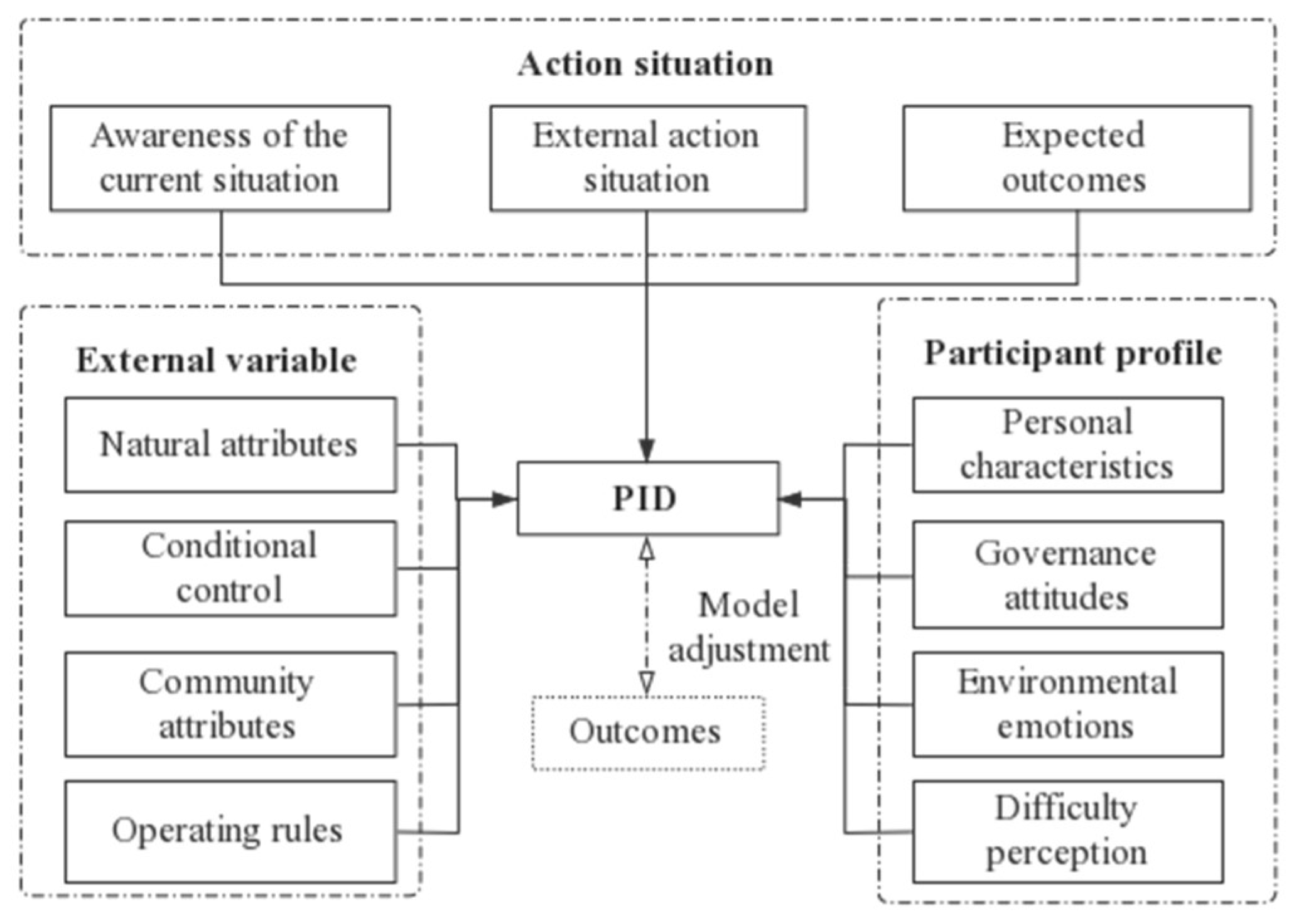

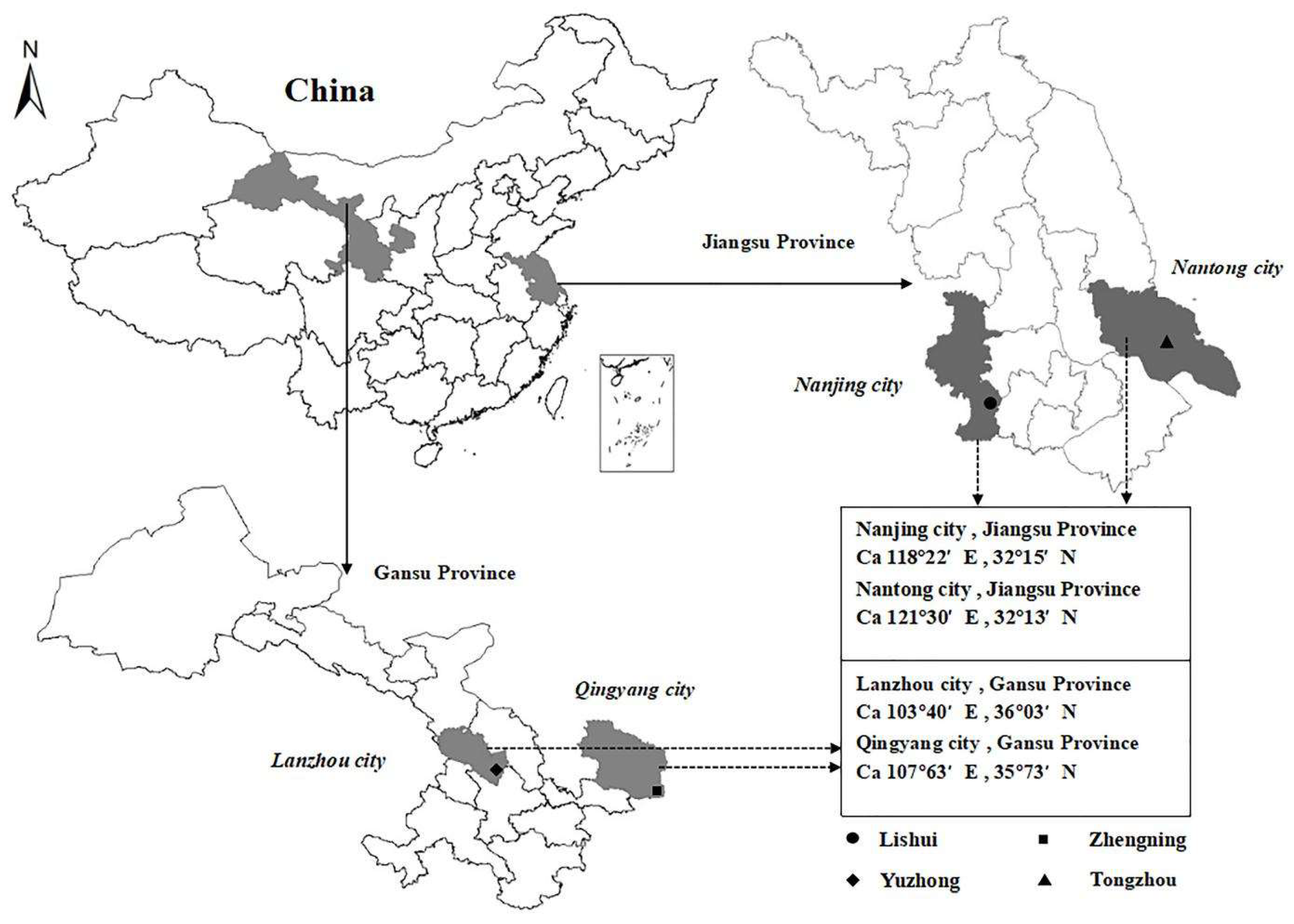
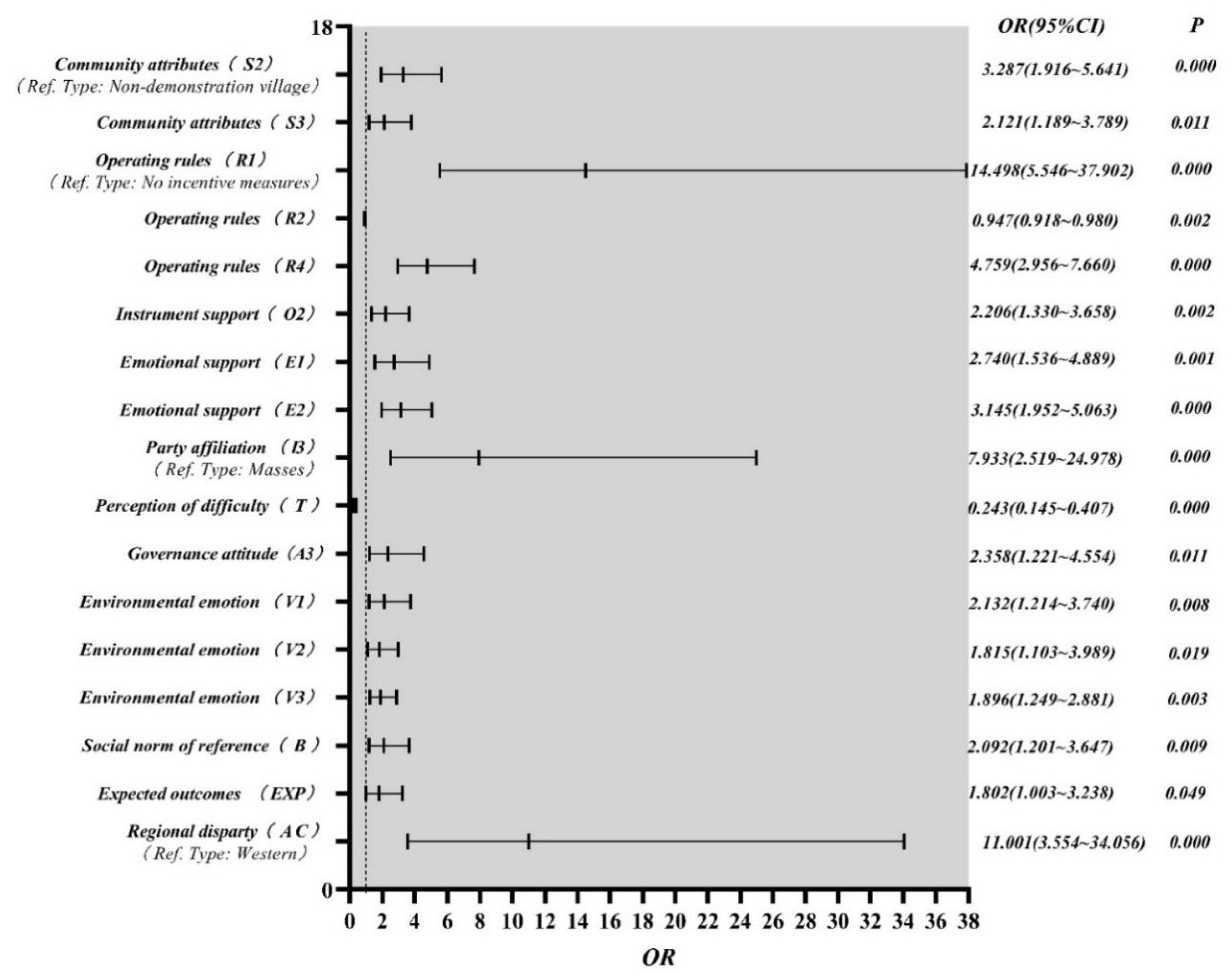
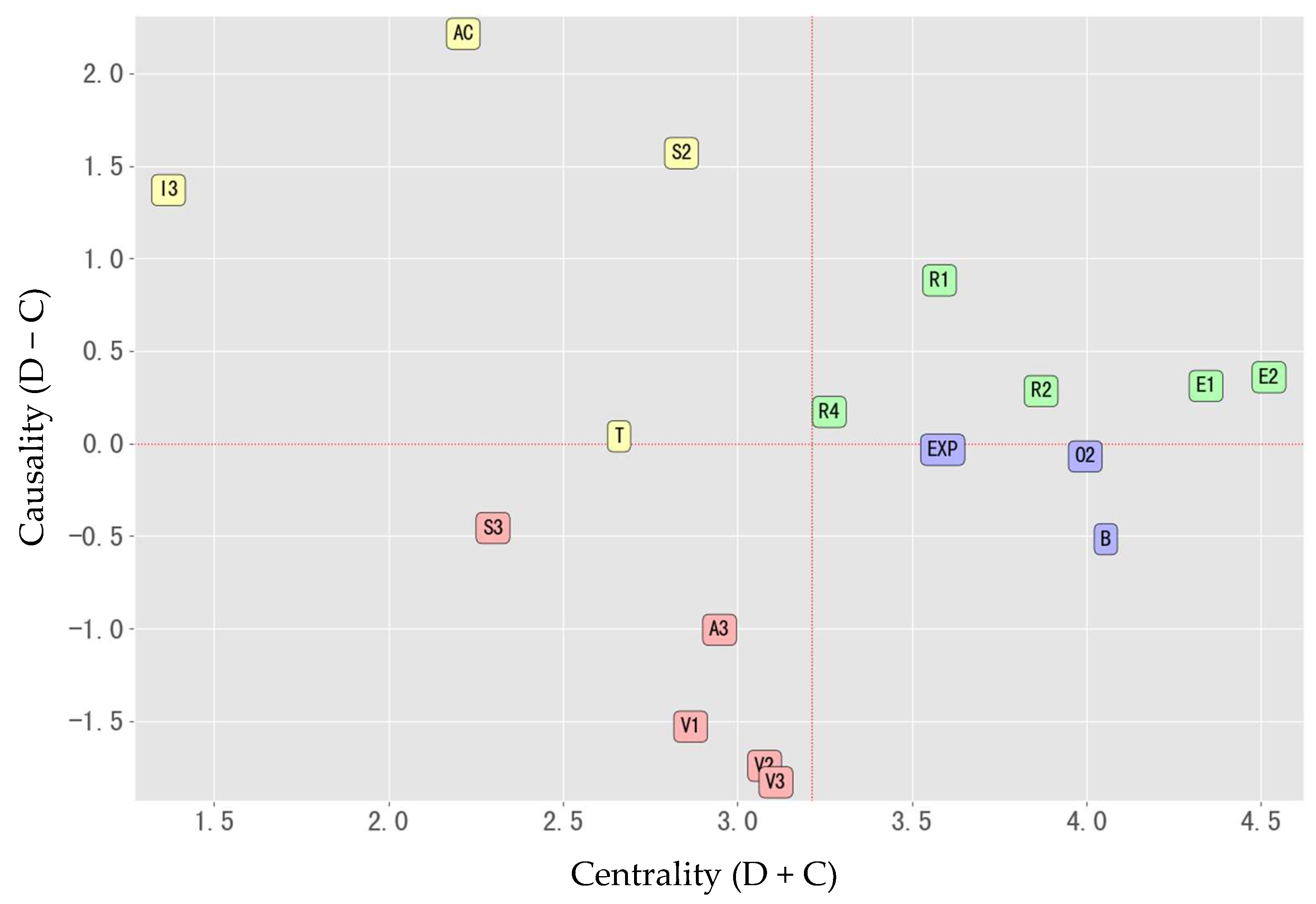
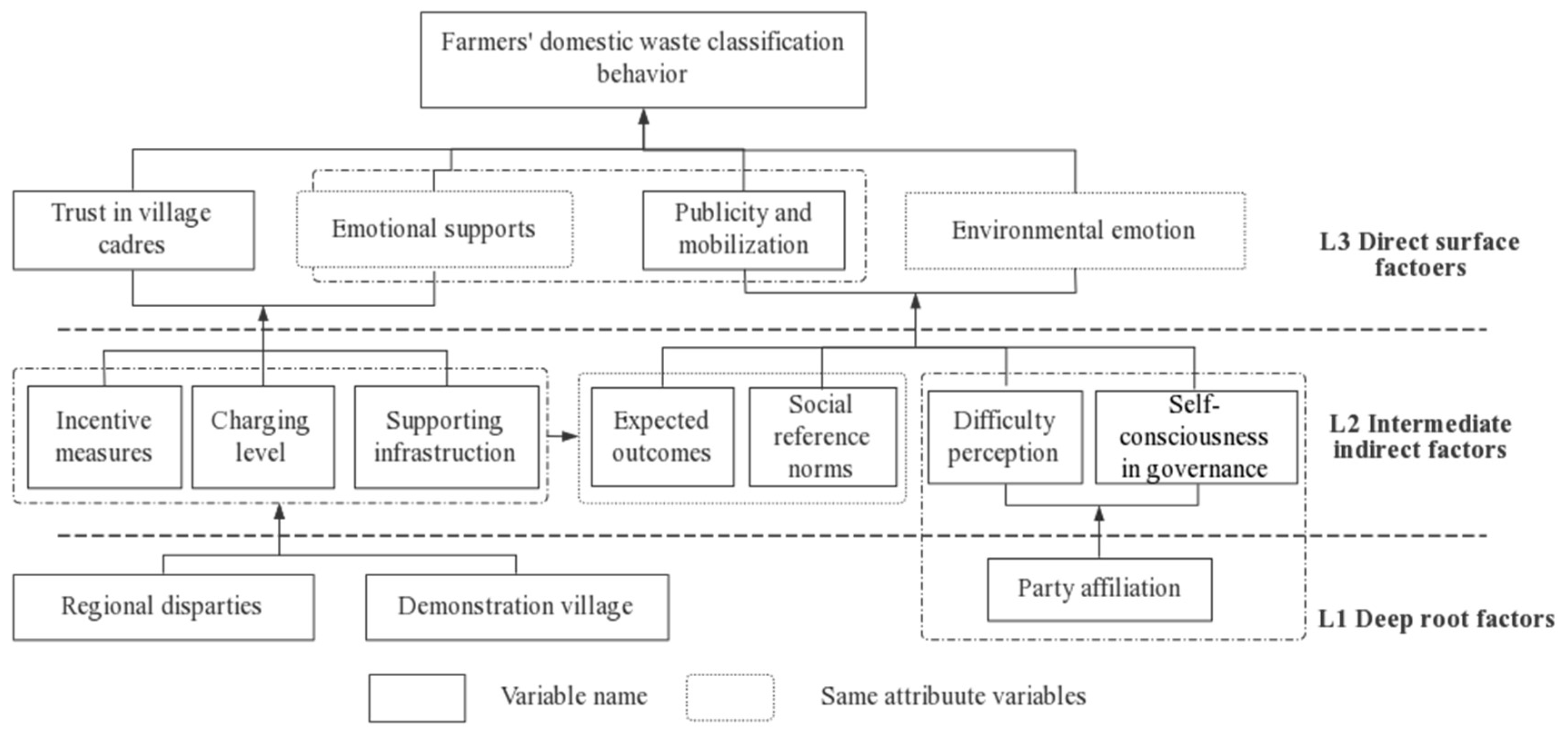
| Variable | Connotation Interpretation | Mean | Standard Deviation | Expected Direction | ||
|---|---|---|---|---|---|---|
| Classification of domestic waste | RC | How many categories do the respondents classify their domestic waste when they throw it away? | 1.941 | 0.834 | ||
| Natural attributes | N1 | Distance from the village to the county seat (km) | 24.696 | 13.366 | - | |
| Participant Status | personal characteristic | I1 | sex (male = 1; female = 0) | 0.494 | 0.5 | ? |
| I2 | age (<18 = 1; 18–25 = 2; 26–30 = 3; 31–40 = 4; 41–50 = 5; 51–60 = 6; >60 = 7) | 4.907 | 1.531 | - | ||
| I3 | Whether a member of the CPC (Yes = 1; No = 2) | 1.902 | 0.297 | + | ||
| Governance attitude | A1 | Rural waste, sewage, and village appearance need to be addressed (Likert 5-point scale; the higher the value, the better the attitude of farmers to address the issue) | 4.294 | 0.735 | + | |
| A2 | Rational segregation and disposal of domestic waste protects the environment and is good for health (ibid.) | 3.994 | 0.955 | + | ||
| A3 | Village sanitation depends on everyone’s self-consciousness (ibid.) | 3.741 | 1.024 | + | ||
| Environmental emotion | V1 | Participation in environmental management is pleasant (Likert 5-point scale; the higher the value, the stronger the environmental sentiment of the farmers) | 3.471 | 1.017 | + | |
| V2 | Uneasy about not participating in environmental governance (ibid.) | 3.529 | 1.024 | + | ||
| V3 | Participation in environmental governance is recognized and applauded by all (ibid.) | 3.065 | 1.017 | + | ||
| Perception of difficulty | T | How difficult it is for you to sort waste (Likert 5-point scale; the higher the value, the more difficult it is) | 3.748 | 1.014 | - | |
| Conditional control | Family background | F1 | Total family population | 4.25 | 1.271 | ? |
| F2 | Highest level of education in the family (illiterate = 1; not educated but literate = 2; elementary school = 3; middle school = 4; high school = 5; college = 6; graduate = 7) | 4.457 | 1.314 | + | ||
| F3 | What is the level of household income in the village (5-point Likert scale; the higher the value, the higher the level of income in the village) | 2.984 | 0.64 | + | ||
| Community attributes | S1 | Neighborhood trust level (Likert 5-point scale; the higher the value, the higher the level of trust) | 3.999 | 0.739 | + | |
| S2 | Whether the village has been assessed as a demonstration village (Yes = 1; No = 2) | 1.722 | 0.448 | + | ||
| S3 | Level of trust in village cadres (Likert 5-point scale; the higher the value, the higher the level of trust). | 3.351 | 0.991 | + | ||
| Operating rules | R1 | Availability of incentives and disincentives (Yes = 1; No = 2) | 1.597 | 0.49 | + | |
| R2 | Current charges for waste management in the village (RMB/month) | 6.121 | 13.813 | - | ||
| R3 | Whether there are village rules and regulations (Yes = 1; No = 2) | 1.497 | 0.5 | + | ||
| R4 | Waste transport in the village (no unified transport = 1; mixed transport not timely = 2; mixed transport timely = 3; sorted transport not timely = 4; sorted transport timely = 5) | 3.18 | 1.135 | + | ||
| Awareness of the current situation | Instrument support | O1 | The government provides funds for remediation and improves supporting infrastructure (Likert 5-point scale; the higher the value, the higher the level of perceived support). | 3.606 | 0.932 | ? |
| O2 | The government and the village committee will provide publicity and guidance and organize and mobilize villagers to participate in waste separation and environmental protection (ibid.) | 3.354 | 1.095 | + | ||
| Emotional support | E1 | The government and village committee will try their best to solve the difficulties encountered by villagers in waste separation (ibid.) | 3.369 | 1.134 | + | |
| E2 | The government and village committee will pay attention to the actual needs of villagers in waste separation and respect their opinions (ibid.) | 2.423 | 0.913 | + | ||
| External action situation | Social norm of reference | B | The number of villagers involved in waste classification in this village (Likert 5-point scale, the larger the value, the more people become involved) | 3.468 | 1.165 | + |
| Expected outcomes | EXP | Environmental improvement effect (Likert 5-point scale, the larger the value, the better the expected governance effect) | 3.948 | 0.864 | + | |
| Control variable | Regional disparity | AC | East and West (dummy variable; Eastern = 1; Western = 2) | 1.448 | 0.497 | + |
| Variable | Estimation Coefficient | Standard Error | Significance | OR | Variable | Estimation Coefficient | Standard Error | Significance | OR |
|---|---|---|---|---|---|---|---|---|---|
| N | −0.178 | 0.262 | 0.497 | 0.837 | I2 | 0.130 | 0.129 | 0.313 | 1.139 |
| S1 | −0.200 | 0.296 | 0.500 | 0.819 | I3: Party = 1 | 2.071 | 0.585 | 0.000 | 7.933 |
| S2: Demonstration village = 1 | 1.190 | 0.352 | 0.000 | 3.287 | I3: Masses = 2 | 0a | |||
| S2: Non-demonstration village = 2 | 0a | T | −1.416 | 0.264 | 0.000 | 0.243 | |||
| S3 | 0.752 | 0.296 | 0.011 | 2.121 | A1 | −0.446 | 0.303 | 0.142 | 0.640 |
| R1: Incentive measures = 1 | 2.674 | 0.442 | 0.000 | 14.498 | A2 | 0.071 | 0.352 | 0.841 | 1.074 |
| R1: No incentive measures = 2 | 0a | A3 | 0.858 | 0.336 | 0.011 | 2.358 | |||
| R2 | −0.054 | 0.017 | 0.002 | 0.947 | V1 | 0.757 | 0.287 | 0.008 | 2.132 |
| R3: Village rules and regulations = 1 | 0.427 | 0.568 | 0.453 | 1.533 | V2 | 0.596 | 0.254 | 0.019 | 1.815 |
| R3: No village rules and regulations = 2 | 0a | V3 | 0.640 | 0.213 | 0.003 | 1.896 | |||
| R4 | 1.560 | 0.243 | 0.000 | 4.759 | F1 | −0.201 | 0.163 | 0.218 | 0.818 |
| O1 | −0.084 | 0.295 | 0.775 | 0.919 | F2 | −0.094 | 0.237 | 0.690 | 0.910 |
| O2 | 0.791 | 0.258 | 0.002 | 2.206 | F3 | 0.292 | 0.388 | 0.452 | 1.339 |
| E1 | 1.008 | 0.295 | 0.001 | 2.740 | B | 0.738 | 0.283 | 0.009 | 2.092 |
| E2 | 1.146 | 0.243 | 0.000 | 3.145 | EXP | 0.589 | 0.299 | 0.049 | 1.802 |
| I1: Female = 0 | −0.084 | 0.369 | 0.820 | 0.919 | AC: Eastern = 1 | 2.398 | 0.431 | 0.000 | 11.001 |
| I1: Male = 1 | 0a | AC: Western = 2 | 0a | ||||||
| No classification | 21.305 | 3.320 | 0.000 | —— | |||||
| Two categories | 41.018 | 4.460 | 0.000 | —— | |||||
| Three categories | 51.202 | 4.940 | 0.000 | —— |
Disclaimer/Publisher’s Note: The statements, opinions and data contained in all publications are solely those of the individual author(s) and contributor(s) and not of MDPI and/or the editor(s). MDPI and/or the editor(s) disclaim responsibility for any injury to people or property resulting from any ideas, methods, instructions or products referred to in the content. |
© 2024 by the authors. Licensee MDPI, Basel, Switzerland. This article is an open access article distributed under the terms and conditions of the Creative Commons Attribution (CC BY) license (https://creativecommons.org/licenses/by/4.0/).
Share and Cite
Wang, J.; Zhao, N.; Li, D.; Li, S. A Study of Farmers’ Behavior in Classifying Domestic Waste Based on the Participants Intellectual Decision Model. Agriculture 2024, 14, 791. https://doi.org/10.3390/agriculture14060791
Wang J, Zhao N, Li D, Li S. A Study of Farmers’ Behavior in Classifying Domestic Waste Based on the Participants Intellectual Decision Model. Agriculture. 2024; 14(6):791. https://doi.org/10.3390/agriculture14060791
Chicago/Turabian StyleWang, Jing, Nan Zhao, Dongjian Li, and Shiping Li. 2024. "A Study of Farmers’ Behavior in Classifying Domestic Waste Based on the Participants Intellectual Decision Model" Agriculture 14, no. 6: 791. https://doi.org/10.3390/agriculture14060791
APA StyleWang, J., Zhao, N., Li, D., & Li, S. (2024). A Study of Farmers’ Behavior in Classifying Domestic Waste Based on the Participants Intellectual Decision Model. Agriculture, 14(6), 791. https://doi.org/10.3390/agriculture14060791





